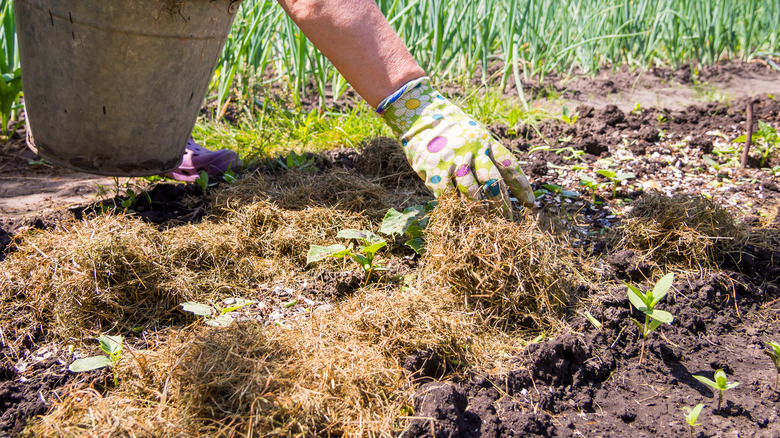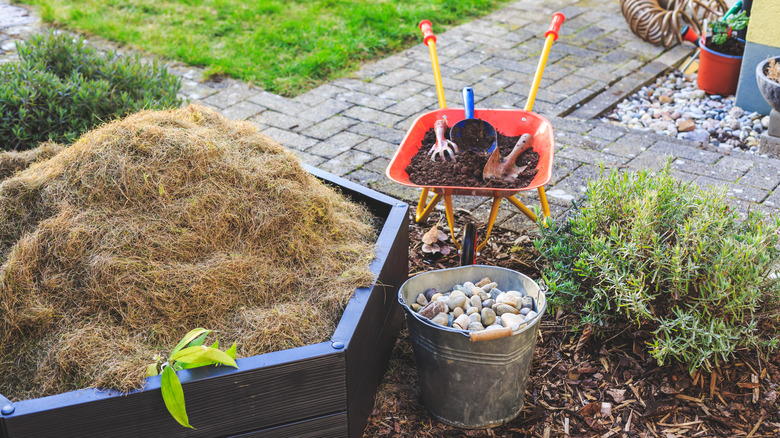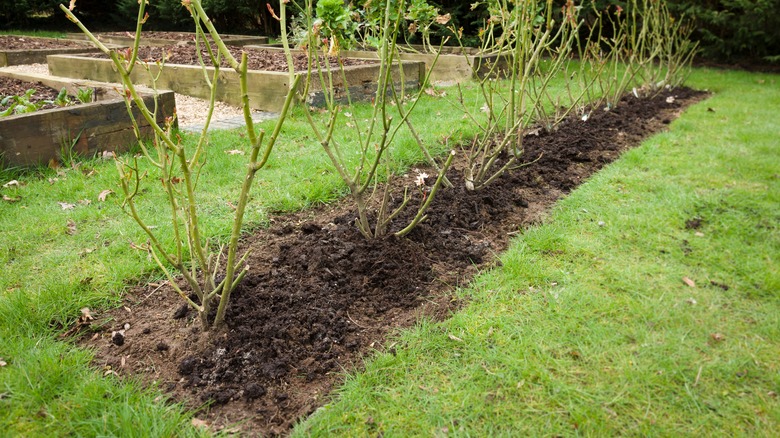How To Best Mulch Your Garden This Fall
Mulches are known as the gardener's friend, according to Almanac, and for the best of reasons. Mulch promotes healthy plant growth by mimicking a forest floor, explains CBS DFW. It is a layer of material that a grower lays down around their plants — in nature and in most domestic situations, that is going to be organic material of some kind like grass clippings, wood chips, compost, or sawdust. This layer of material has an amazing number of benefits for plants and gardeners alike.
By insulating the soil from the air, mulch keeps temperatures constant and reduces evaporation. By blocking the leaves of all but the plants you want to keep, mulch also suppresses weeds, giving the garden a tidier appearance, notes RHS. In the wetter months of your growing year, mulch also helps slow rainfall down as it hits the ground. This reduces the amount of soil erosion from your land, but because the best mulches are themselves decomposing organic matter, the rain will act as a gentle fertilizer as it washes through the layer of mulch.
If you want to begin your own gardener's friendship with mulch this fall, you need to know what the best mulching materials are, and how to go about mulching at this time of the year.
The best mulch is what you have
The best mulch for your garden is the mulch you can get your hands on. If you're just starting out with this, grass clippings are a safe and simple mulch that most gardeners have access to. When it comes to grass mulch, University of Minnesota Extension recommends only applying a thin layer. Because of their fine texture, any deeper than 2 inches is advised against, as this can block air and lead to some nasty smells. It's important to make sure the grass clippings you are using are dry and also free of herbicides or other nasties you don't want leaching into your plants.
According to The Home Depot, however, one of the most popular mulch choices in the Southeastern United States is pine needles. They are low-maintenance, natural, and mimic the forest floor amazingly well.
Although you can't use mulch in place of compost, you can use compost as a mulch, if you have enough of it — or are prepared to buy it at great expense. As compost is just fully rotted organic material, this would be the ideal mulch for a flowerbed or if you wanted to adopt a no-till approach, according to Permaculture Research Institute. It is critical to ensure you know that the compost was well made though, in order to ensure that all weed seeds have been killed properly and the mulch does its job.
How to mulch in the fall
With fall mulching, there are two main factors to be aware of. The first is temperature — which is one of the major reasons for doing this work, according to Planet Natural Research Center. Plants make potentially life-changing decisions based on temperature — knowing when to wake up for spring is a crucial example. The better your soil insulation the more likely it is that early October cold snaps won't take your garden out of commission a month early, and a late February heatwave doesn't trick your plants into thinking spring had really sprung.
The second factor to actively monitor is moisture. Fall is a wet time for many homeowners, and we don't want the mulch to completely restrict the flow of moisture or air in and out of the soil and to your plants. According to Tree Care Tips, mulch should slow flows down, but not stop them entirely, as this can lead to anaerobic decomposition, nasty smells, and rotting. This becomes a danger if the mulch layer is too thick or if the mulch material is too fine.
So, this fall, mulch your garden with a layer of available organic material that's thick enough to aid with temperature regulation and moisture retention — but be certain not to let it turn sour or waterlogged.


